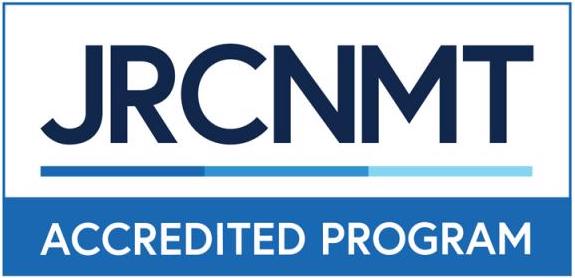 The purpose of program evaluation is to systematically study, investigate and appraise the effectiveness of the Nuclear Medicine and Molecular Imaging Sciences program in order to ensure that the program continues to provide a signature educational program that produces graduates who are prepared to be leaders in their field. Graduate outcomes are indicators of program effectiveness, demonstrating the extent to which a program achieves its goals.
The purpose of program evaluation is to systematically study, investigate and appraise the effectiveness of the Nuclear Medicine and Molecular Imaging Sciences program in order to ensure that the program continues to provide a signature educational program that produces graduates who are prepared to be leaders in their field. Graduate outcomes are indicators of program effectiveness, demonstrating the extent to which a program achieves its goals.
Reported Data
Programmatic graduate outcomes data reported on the Joint Review Committee on Educational Programs in Nuclear Medicine Technology (JRCNMT) website include: 5-year time period of current report; graduation rate; The American Registry of Radiologic Technologists (ARRT) credentialing success; Nuclear Medicine Technology Certification Board (NMTCB) credentialing success and job placement rate.
-
Program Mission
The mission of the Master of Science in Nuclear Medicine and Molecular Imaging Sciences (NMMIS) program in the School of Health Professions at the University of Alabama at Birmingham (UAB) is to provide comprehensive didactic and clinical educational experiences reflecting 21st century workforce demands that prepare graduates to be competent practitioners and innovative leaders within the nuclear medicine profession.
-
Program Goals
- Provide students with the knowledge and skills necessary for the practice of nuclear medicine in one of the chosen specializations as an imaging specialist, or radiation safety officer, or independent researcher.
- Provide students with the knowledge necessary to pass national certification.
- Provide health care employers with competent graduates.
- Offer educational activities and materials to the health care community.
- Provide help for students with future graduate school request.
-
Student Learning Objectives
- The graduate will obtain the knowledge required for entry-level practice as a Nuclear Medicine Technologist
- The imaging specialist track graduate will obtain the knowledge required for entry-level practice as a Computed Tomography (CT) Technologist.
- The graduate will demonstrate cognitive and psychomotor skills required for clinical practice.
- The graduate will apply didactic knowledge to clinical practice.
- The nuclear medicine and molecular imaging sciences program will graduate student who can apply concepts towards a non-thesis or thesis research project.
Program Outcomes:
Post-Baccalaureate Accreditation approval is maintained through 2024 from the JRCNMT.
Graduate achievement data is an indicator of program effectiveness, demonstrating the extent to which a program achieves its goals. The current report on graduate achievement data, identified by program, is available on the JRCNMT website by clicking on the following link: Graduate Achievement Report.
-
NMMIS Program First Time Pass Rate for NMTCB Certification
Year UAB NMMIS Program National Average for Equivalent Programs National Average Overall 2009 100% 94% 90% 2010 93% 92% 88% 2011 94% 93% 91% 2012 88% 91% 89% 2013 100% 91% 88% 2014 89% 90% 88% 2015 92% 91% 87% 2016 82% 89% 83% -
UAB NMMIS Applicant and Class Data
NMMIS Applicant and Class Data 2011 2012 2013 2014 2016 Applications Received n/a 34 28 38 5 Enrolled 21 20 16 19 5 Average Entering GPA 3.56 3.21 3.14 3.07 3.07 *2015 - No entering class data due to transition from BS to MS degree.
-
UAB NMMIS Cohort Data
NMMIS Cohort Data 2011-2013 2012-2014 2013-2015 2014-2016 Enrolled 21 20 16 19 Academic Attrition 2 2 3 1 Personal Attrition 1 0 0 0 Graduated 18 18 13 17 Graduated Rate 86% 90% 81% 89% -
UAB NMMIS Graduate Employment and Education Outcomes
UAB NMMIS Graduate Outcomes 2012 2013 2014 2015 2016 Employed in NMT 57.1% 68.8% 38.5% 67% 90% Enrolled in Education Program 30.8% 14.3% 23.0% 0.0% 5%
